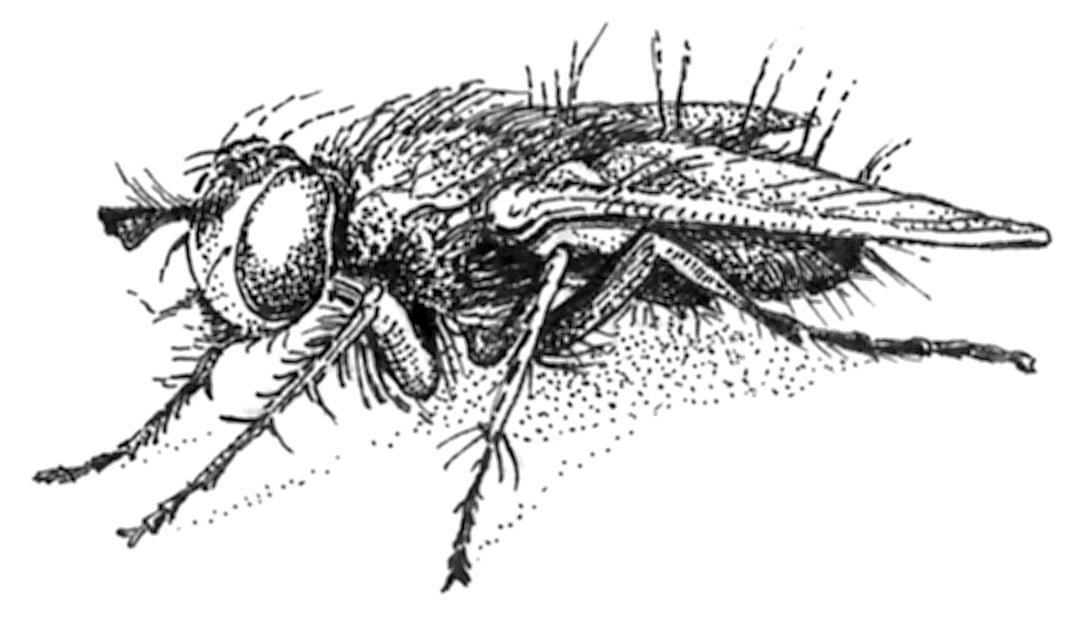
Garden Allies: Tachinid Flies

Contributor

The Good, The Bad, and The Ugly
Husbands, we are told, should give their wives flowers, chocolates, or other romantic gifts. Instead, my husband once presented me with an enormous tachinid fly that he had caught at work. What an inspired gift! I was far more impressed with the fact that he had caught such a robust and rapid flyer with a small-mouthed bottle than I would have been with an easily purchased bouquet, and I continue to be appreciative of the laugh the story elicits.
The bristly fly he caught, Bombyliopsis abrupta, is our largest West Coast tachinid, and readily recognizable (one entomology student commented that it looked like it should be riding a Harley, and I have ever after called it Harry Tachina). Most tachinids, however, are not so easily discerned from other flies, and many superficially resemble the common housefly. Tachinids serve as a perfect example of why it is a good idea to encourage overall insect diversity in the garden, avoid the use of pesticides, and enhance populations of natural enemies—the beneficial insects and other organisms which regulate pest populations. Identifying every insect we see is simply too great a task for most gardeners, and, in this case, looks may be deceiving.

A Broad Diet
Tachinids are the most diverse family of Diptera (true flies), and help control many pests; of the parasitic insects, only parasitoid wasps are of greater importance. All of the known species of tachinids are parasitoids: they deposit their eggs on or near host arthropods, and the larvae parasitize the host, in most cases resulting in the victim’s death. Parasitoids (as opposed to parasites) are free-living as adults; many of the common garden tachinids are flower visitors, feeding on nectar and pollen as adults. Tachinids parasitize a broad range of hosts from several orders of insects, among them Lepidoptera (butterflies and moths), Coleoptera (beetles, especially scarabs and leaf beetles), and Orthoptera (grasshoppers and crickets). In the Hymenoptera (wasps, bees, and ants), they specialize on sawflies, a common herbivorous pest. They are also known to attack a few other arthropods besides insects, particularly centipedes.
Tachinids are endo-parasitoids, meaning that they develop within their host. They are also koinobionts, a term for a parasitoid that does not prevent its host from continuing its own growth and development (they do not inject paralyzing toxins into their host). Although many hosts are parasitized in an early larval stage, the victim of a koinobiont continues to grow and eat; the parasite usually emerges from the pupal stage of its host, by which time the hapless host has died. For gardeners, this means that pests are not usually controlled by tachinids in the first generation, as the pest continues its herbivorous lifestyle until pupation. Subsequent generations, however, may be suppressed, as parasitized individuals do not emerge from pupation to breed and produce another generation. We first visited koinobiont parasitoids in an article on braconids that included Cotesia glomerata, a parasitoid of the Pieris rapae, the cabbage butterfly. The opposite of koinobiont, by the way, is an idiobiont, a parastoid that halts the growth and development of its host (usually by injecting a paralyzing toxin). Tachinids usually attack the larval stage of the host, and some species attack adult hosts; they never attack egg or pupal stages.
Finding Their Host
Most koinobiont parasitoids, such as wasps, are highly specialized, preying on a single species of insect; tachinids, however, often have a broad host range, victimizing insects in different genera, different families, and even different orders. Compsilura concinnata, for instance, attacks almost 200 species of insects, in many families and in three different orders! Because most tachinids do not have a piercing ovipositor, they have evolved other strategies for egg laying. Those that lay their eggs near the host species will lay many more than those that directly deposit the eggs on their host; the hungry larvae that emerge at some distance risk starving before finding a victim. Some tachinids have evolved a strategy in which they lay many thousands of “micro-eggs” that the host ingests while it innocently munches on leaves. Some tachinids incubate their eggs internally, laying eggs with fully formed larvae that emerge immediately when laid on or near their hosts. Pupation takes place in the host or in leaf and soil litter. Adults are found in many different habitats, a good reason to develop micro-habitats within a garden. They are generally diurnal or crepuscular (active at dawn and dusk.)
Tachinid flies are used in a number of biological control programs, and are considered to be equivalent in effectiveness to the more commonly used parasitic wasps. Given their potential in regulating populations of pests, they are receiving increasing attention from researchers who study biological control. Tachinids are also useful in evolutionary biology and ecology, and are studied to advance our understanding of basic biological processes. I think of this, as I pause in my garden, to watch the Trichopoda pinnipes, a small amber-colored fly possessing elegant polished black legs with large “combs” on the rear femur, bright against the verdant leaves of a giant polygonum. I am glad that tachinids are being studied, but, in my garden, it is enough to simply include a variety of plants to attract them. Tachinids have a welcome home in my landscape, where I am grateful for their sophisticated pest regulating adaptations, leaving me free to simply enjoy their frequent visits.

In a Nutshell
Popular Names:
Tachina flies, tachinids
Scientific Name:
Order: Diptera. Family: Tachinidae is in the superfamily Oestroidea, which includes flesh flies (Sarcophagidae), bottle flies (Calliphoridae), and bot flies (Oestridae).
Common Species:
Trichopoda pennipes, Voria ruralis, Erynnia tortricis, Hystricia abrupta.
Distribution:
Worldwide, more than 1520 genera, and about 10,000 described species; 1,300 species in North America.
Appearance:
Eggs: small white ovals, laid singly, on or near host. Larvae: maggots (legless larvae). Pupae: pupates in host or leaf litter. Adults: two-winged fly. Size ranges from about 2 mm to more than 20 mm. Often small, black or grey, resembling house flies, or may have vivid markings in yellow, orange, red, and even metallic blue or green. Some are wasp and bee mimics.
Life Cycle:
All are parasitoids: larvae develop in host insects, killing them before emerging.
Life Span:
Larvae usually develop in about one to three weeks, but some species enter diapause (a state of suspended development) in the host.
Diet:
Includes larval Lepidoptera (butterflies and moths), Coleoptera (scarabs and leaf beetles), Hymenoptera (sawflies), Hemiptera (true bugs), and centipedes.
Favorite plants:
Flowers in the daisy (Asteraceae) and dill (Apiaceae) families. Some tachinids act as pollinators.
Benefits:
Can be effective in regulating populations of herbivorous insects. About one hundred species have been used in biological control programs.
Problems:
May be too effective in regulating caterpillars if a butterfly garden is the goal! Silkworm “ranchers” consider tachinid flies to be pests; the uzi fly (Exorista bombycis) is their bane.
Interesting facts:
Tachinids use diverse strategies to locate hosts. Some, such as Trichopoda pennipes, use the pheromone of their hemipteran prey. Ormia ochracea uses the mating call of its cricket prey to locate its host; the cricket, while attracting its mate, is simultaneously attracting its doom!
Sources:
Many species are available commercially and useful in agriculture, but garden species are easily attracted with richly planted landscapes.
More information:
For those who wish to delve into some serious science, a great resource is found in Annual Review of Entomology: Tachinidae: Evolution, Behavior, and Ecology, by John O Stireman et al. The journal is available at many university libraries.
Share:
Social Media
Garden Futurist Podcast
Most Popular
Videos
Topics
Related Posts

Low Maintenance Gardens – Better for Pollinators and People
Autumn 2022 “I come out every day. It’s therapy, my meditation.” Janet’s young garden transformed from overgrown, invasive plants to mostly natives. The dailiness of

Calochortophilia: A Californian’s Love Affair with a Genus
Summer 2022 I can chart the progression of my life by Calochortus. For the last two decades, at least. As a teenage girl growing up

Pacific Plant People: Carol Bornstein
Spring 2022 Public gardens play a key role in demonstrating naturalistic planting design, selecting native and adapted plants for habitat, and testing techniques for reducing

Add Year-Round Interest and Winter Blooms for Pollinators
Spring 2022 This article was created from an Interview by Merrill Jensen with Neil Bell in the Summer of 2021 for our Pacific Plant People











Responses